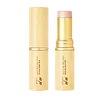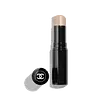What's inside
What's inside
 Key Ingredients
Key Ingredients

 Benefits
Benefits

No benefits
 Concerns
Concerns

 Ingredients Side-by-side
Ingredients Side-by-side

Diisostearyl Malate
EmollientOctyldodecanol
EmollientPhenylpropyldimethylsiloxysilicate
EmollientTriethylhexanoin
MaskingPolybutene
Pyrus Malus Seed Oil
EmollientBis-Diglyceryl Polyacyladipate-2
EmollientHydrogenated Vegetable Oil
EmollientSynthetic Wax
AbrasiveParaffin
PerfumingPentaerythrityl Tetraisostearate
EmollientSynthetic Fluorphlogopite
Hydrogenated Polydecene
EmollientDiglyceryl Sebacate/Isopalmitate
EmollientTrilaurin
Skin ConditioningVp/Eicosene Copolymer
Polyethylene
AbrasiveCI 77891
Cosmetic ColorantSilica Dimethyl Silylate
EmollientMangifera Indica Seed Butter
Skin ConditioningTheobroma Cacao Seed Butter
EmollientAstrocaryum Murumuru Seed Butter
EmollientHydrolyzed Collagen
EmollientLactobacillus/Soybean Extract Ferment Filtrate
Skin ConditioningAcetylated Sucrose Distearate
EmollientCaprylic/Capric Triglyceride
MaskingEthylene/Propylene Copolymer
AbrasiveSilica
AbrasiveMicrocrystalline Wax
Emulsion StabilisingStearalkonium Hectorite
Gel FormingCaprylyl Glycol
EmollientGlyceryl Caprylate
EmollientPropylene Carbonate
SolventTriethoxycaprylylsilane
Pentaerythrityl Tetra-Di-T-Butyl Hydroxyhydrocinnamate
AntioxidantWater
Skin ConditioningDipropylene Glycol
HumectantCeramide AP
Skin Conditioning1,2-Hexanediol
Skin ConditioningTocopherol
AntioxidantMica
Cosmetic ColorantCI 77491
Cosmetic ColorantDiisostearyl Malate, Octyldodecanol, Phenylpropyldimethylsiloxysilicate, Triethylhexanoin, Polybutene, Pyrus Malus Seed Oil, Bis-Diglyceryl Polyacyladipate-2, Hydrogenated Vegetable Oil, Synthetic Wax, Paraffin, Pentaerythrityl Tetraisostearate, Synthetic Fluorphlogopite, Hydrogenated Polydecene, Diglyceryl Sebacate/Isopalmitate, Trilaurin, Vp/Eicosene Copolymer, Polyethylene, CI 77891, Silica Dimethyl Silylate, Mangifera Indica Seed Butter, Theobroma Cacao Seed Butter, Astrocaryum Murumuru Seed Butter, Hydrolyzed Collagen, Lactobacillus/Soybean Extract Ferment Filtrate, Acetylated Sucrose Distearate, Caprylic/Capric Triglyceride, Ethylene/Propylene Copolymer, Silica, Microcrystalline Wax, Stearalkonium Hectorite, Caprylyl Glycol, Glyceryl Caprylate, Propylene Carbonate, Triethoxycaprylylsilane, Pentaerythrityl Tetra-Di-T-Butyl Hydroxyhydrocinnamate, Water, Dipropylene Glycol, Ceramide AP, 1,2-Hexanediol, Tocopherol, Mica, CI 77491
 Reviews
Reviews

Ingredients Explained
These ingredients are found in both products.
Ingredients higher up in an ingredient list are typically present in a larger amount.
Ci 77491 is also hydrated iron III oxide. It's sole purpose is to give a red/pink hue to products.
Iron III oxides are classified as inorganic chemicals for coloring.
Synthetically created Ci 77491 is considered safer than those naturally found. This is because the synthetically created version may contain less impurities. Iron oxides are generally non-toxic and non-allergenic.
Learn more about CI 77491Ci 77891 is a white pigment from Titanium dioxide. It is naturally found in minerals such as rutile and ilmenite.
It's main function is to add a white color to cosmetics. It can also be mixed with other colors to create different shades.
Ci 77891 is commonly found in sunscreens due to its ability to block UV rays.
Learn more about CI 77891Diisostearyl Malate is an emollient and most often used in lip products. It comes from isostearyl alcohol, a fatty acid, and malic acid, an AHA.
As an emollient, Diisostearyl Malate helps create a thin film on your skin to trap moisture in. This helps keep your skin soft and smooth.
Mica is a naturally occurring mineral used to add shimmer and color in cosmetics. It can also help improve the texture of a product or give it an opaque, white/silver color.
Serecite is the name for very fine but ragged grains of mica.
This ingredient is often coated with metal oxides like titanium dioxide. Trace amounts of heavy metals may be found in mica, but these metals are not harmful in our personal products.
Mica has been used since prehistoric times throughout the world. Ancient Egyptian, Indian, Greek, Roman, Aztec, and Chinese civilizations have used mica.
Learn more about MicaOctyldodecanol is a fatty alcohol. It is primarily used to enhance the texture of products.
As an emulsifier, Octyldodecanol helps prevent the oils and waters from separating. It also prevents ingredients from creating foam when shaken.
Octyldodecanol is created by reducing fatty acid to an alcohol.
Due to its high molecular weight, it does not get absorbed into the skin.
Learn more about OctyldodecanolPentaerythrityl Tetra-Di-T-Butyl Hydroxyhydrocinnamate (long name, huh?) is a synthetic antioxidant.
It is used to help stabilize other antioxidants or prevent the color from changing in a product.
As an antioxidant, it helps fight free-radical molecules. Free-radical molecules are capable of damaging our cells and other genetic material. Thus, antioxidants may reduce the signs of aging.
This ingredient is oil-soluble.
Learn more about Pentaerythrityl Tetra-Di-T-Butyl HydroxyhydrocinnamatePolybutene is used to help control the viscosity of a product. This just means it helps adjusts the texture.
It is a polymer and does not get absorbed into the skin due to its large size.
Studies found this ingredient did not irritate skin in concentrations below 15%.
Learn more about PolybuteneSilica, also known as silicon dioxide, is a naturally occurring mineral. It is used as a fine, spherical, and porous powder in cosmetics.
Though it has exfoliant properties, the function of silica varies depending on the product.
The unique structure of silica enhances the spreadability and adds smoothness, making it a great texture enhancer.
It is also used as an active carrier, emulsifier, and mattifier due to its ability to absorb excess oil.
In some products, tiny microneedles called spicules are made from silica or hydrolyzed sponge. When you rub them in, they lightly polish away dead skin layers and enhance the penetration of active ingredients.
Learn more about SilicaSynthetic Fluorphlogopite is the synthethic version of mica. It consists of fluorine, aluminum and silicate.
Synthetic Fluorphlogopite is used to add volume to products.
It is considered non-irritating on the skin.
Learn more about Synthetic FluorphlogopiteSynthetic Wax is created from fossil fuels such as natural gas. It is used to enhance texture, adjust pH, and as an occlusive.
It may also be used as an abrasive ingredient to exfoliate the skin.
Synthetic Wax may not be fungal acne safe.
Learn more about Synthetic Wax